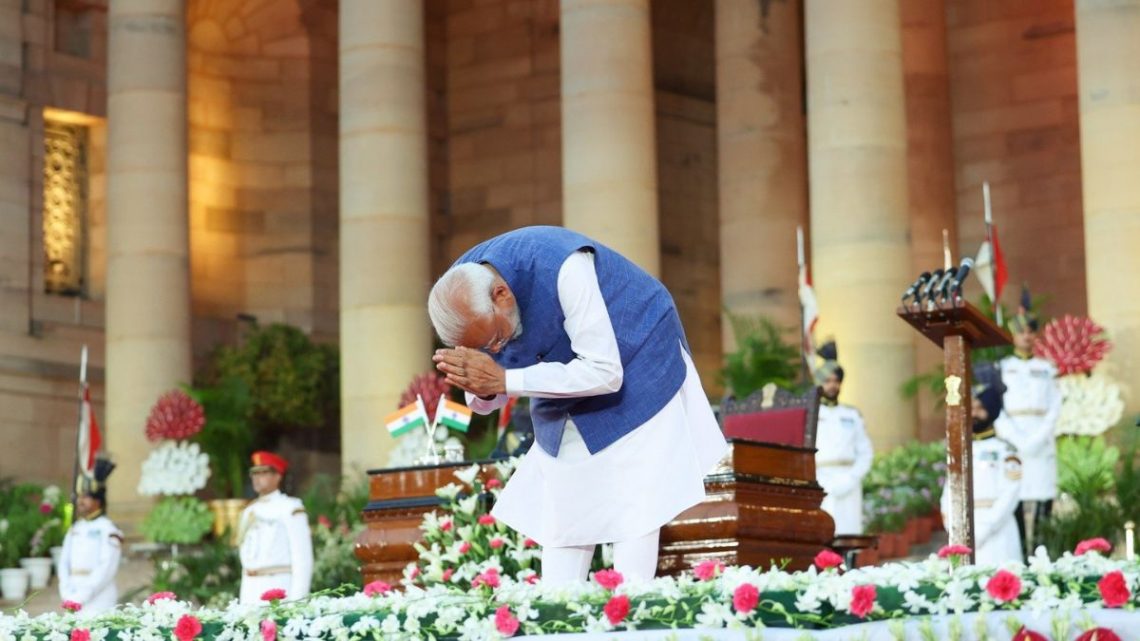In a feat unprecedented in decades, Narendra Modi on Sunday embarked on a third consecutive term as the Prime Minister of India.
After arriving at the Rashtrapati Bhavan’s Forecourt in his cavalcade, Modi walked to the dais with folded hands and bowed to around 8,000 guests in attendance from across the country and leaders from seven countries in South Asia and the Indian Ocean Region. Shortly afterwards, President Droupadi Murmu arrived and, following the National Anthem, Modi was called upon to take oath.
As Murmu administered to him the Oath of Office and Secrecy, Modi became only the second PM of India after Pandit Jawaharlal Nehru to have a third straight term.
Even though Modi has returned to power for the third time, it is set to be a much different term than the first two tenures. This time, he will lead a coalition government as the Bharatiya Janata Party (BJP) failed to get a majority of its own and it had to rely on support from partners in the National Democratic Alliance (NDA) to form a coalition government.
While the BJP won 240 seats, the NDA won 292 seats — well beyond the majority-mark of 272. The Telugu Desam Party (TDP) and Janata Dal-United (JD-U), both of whom joined the NDA just months before the elections, became the kingmakers for the NDA with their respective 16 and 12 seats.
In the 3rd Modi Ministry, there are 71 ministers. They include 30 Cabinet ministers, five Ministers of State (Independent Charge), and 36 Ministers of State.
Even as it’s certain that Modi will retain the ‘Big 4’ portfolios of Home, Defence, Finance, and External Affairs with the BJP and Amit Shah, Rajnath Singh, Nirmala Sitharaman, and S Jaishankar will continue with their respective ministries, the formal allocation of portfolios has not yet been announced.
‘Great blend of youth & experience’: Modi praises his ministers
Modi has praised his Council of Ministers as a “great blend of youth and experience”.
In a post on X (formerly Twitter), Modi said, “Congratulations to all those who have taken oath today. This team of Ministers is a great blend of youth and experience, and we will leave no stone unturned in improving the lives of people.”
That’s indeed the case as while several veterans of the first two terms are there and are expected to retain their previous portfolios, there are several young faces as well, such as Chirag Paswan of the Lokjanshakti Party-Ramvilas (LJP-R) and Jayant Singh of the Rashtriya Lok Dal (RLD).
Modi has also roped in state-based veteran leaders, such as former four-time Madhya Pradesh CM Shivraj Singh Chouhan, former Haryana CM Manohar Lal Khattar, and former Karnataka CM HD Kumaraswami of the Janata Dal-Secular (JD-S).
There are a total of 32 fresh faces in the 3rd Modi Ministry whereas 35 ministers from the previous term have been dropped. While several of those dropped are those who lost elections like Smriti Irani and Rajeev Chandrasekhar, some who won have also been dropped, such as Anurag Thakur and Narayan Tatu Rane.
New pecking order emerges in BJP & NDA
As the 3rd Modi Ministry was sworn-in on Sunday, a new pecking order emerged in the BJP.
While most veterans were retained, there were some notable omissions and additions. For example, Thakur was dropped from the 3rd Modi Ministry and BJP President JP Nadda and Shivraj were inducted. Going by the hierarchy in which the ministers were sworn in, the BJP’s pecking order has evolved in Modi’s third term.
While Modi was the first to take oath, he was followed by Rajnath, who was followed by Shah and Nitin Gadkari.
The new pecking order in the BJP stands as: Modi Rajnath, Shah, Gadkari, JP Nadda, Shivraj Singh Chouhan, Nirmala Sitharaman, S Jaishankar, Manohar Lal Khattar, and Piyush Goyal.
Notably, Kumaraswami took oath between Khattar and Goyal, putting him above many of the BJP’s own ministers in the 3rd Modi Ministry’s pecking order. Other prominent non-BJP ministers include Jitan Ram Manjhi of Hindustan Awam Morcha (HAM) and Lalan Singh of Janata Dal-United (JD-U).
Foreign leaders present, Opposition absent
While leaders from South Asian and Indian Ocean Region nations were present as guests in the swearing-in ceremony, the Opposition was only represented by Mallikarjun Kharge. He was present in his constitutional role of the Leader of the Opposition in Rajya Sabha and not as President of the Congress party.
The foreign leaders who attended the swearing-in included:
After the conclusion of the swearing-in, the leaders went to the stage to greet Modi. Later, President Murmu hosted a banquet for them at the Rashtrapati Bhavan.
As she hosted them, Murmu said the invitation to the leaders from the South Asia and the Indian Ocean region was a sign of India’s ‘Neighbourhood First’ policy and commitment to these regions, as per a statement from the Rashtrapati Bhavan.
“Welcoming the leaders, the President thanked them for accepting the invitation for the swearing-in-ceremony of the new Government, and for joining us in this celebration of democracy. She noted that their presence on this occasion is yet another testament to the centrality of India’s ‘Neighborhood First’ policy, and our SAGAR Vision for the Indian Ocean region. As stakeholders in each other’s progress and well-being, we count on our closest friends and neighbours to work with us to foster peace and prosperity in our region and beyond,” read the statement.
Link to article –
Narendra Modi takes oath as PM of India, NDA govt takes shape with 71 ministers
